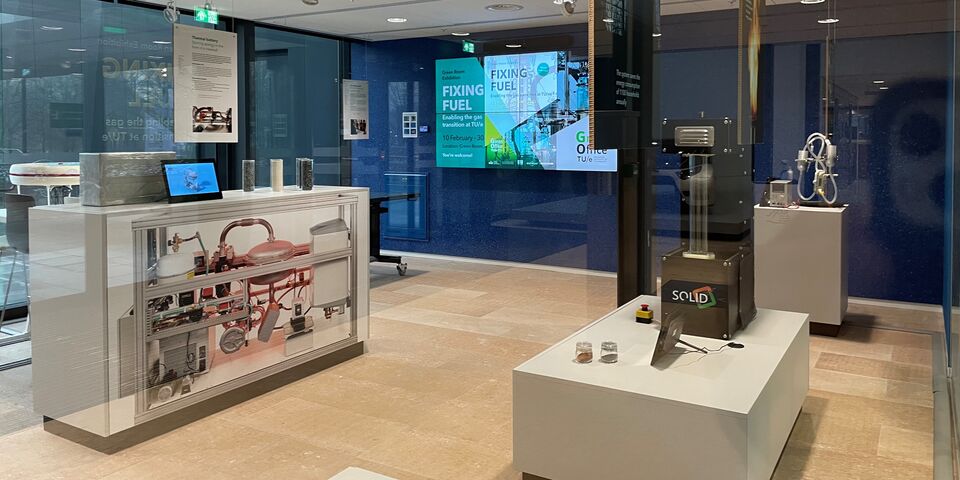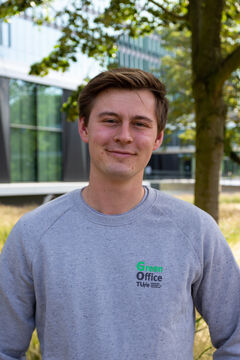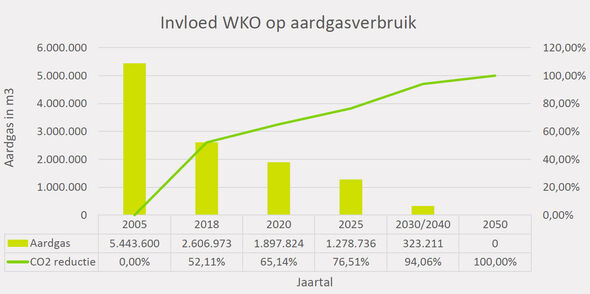How a society without natural gas is being 'fixed' at TU/e
Fixing Fuel, that is the name of the exhibition opening today in the Green Room in Atlas. It is subtitled ‘Powering the society of the future’ and that future is one without natural gas. Bachelor student Mees Groothuis of Go Green Office tells us which innovations are on display, ranging from power derived from hydrogen to a heat storage battery. Also anyone keen to know more about the geothermal system in use at (or, rather, under) TU/e itself can pay a visit to the Green Room before the end of April.
Go Green Office opened a venue in Atlas 0.075 in the middle of last year. Called the Green Room, it is designed to host gatherings, events and exhibitions about sustainability. Here, this afternoon the exhibition Fixing Fuel - Powering the society of the future will open, with Mark Boneschanscher of EIRES as speaker. Due to corona measures, the opening is for invited guests only, but the exhibition is free to visit during Atlas' opening hours until the end of April.
In his capacity as manager of the Green Room, Mees Groothuis (22) is one of the organizers. In his studies too, he is focusing on sustainability. “I am in the last year of my degree at Industrial Design, where I'm working on circularity in production processes. But I'm also interested in renewable energy.”
Gas field
Over the course of ten years in the last century the Netherlands switched from coal to natural gas after a huge gas field was discovered beneath Groningen in 1959, as recalled by Go Green Office in its announcement of the exhibition. Sixty years on we face a new transition, one that will enable us to free ourselves of fossil fuel sources, including the natural gas that is quite literally shaking Groningen to its foundations.
Fixing Fuel gives us an overview of the initiatives at TU/e that are building towards a future with renewable energy, without any dependence on natural gas. Groothuis and his co-organizers were helped to design the exhibition by Mark Boneschanscher of the institute for renewable energy EIRES and by Mark Cox of the Energy Learning Community (ELC). “We know a fair bit ourselves, but these guys are fully aware of all the initiatives and have all the necessary contacts.”
Hydrogen
Visitors to Fixing Fuel will be introduced to technologies such as the heat battery (Cellcius), smart grid modeling (Team RED), energy derived from iron combustion (Team SOLID) and power derived from green hydrogen produced using the Electrolyzer. The TU/e's own geothermical system is also represented in the exhibition (see box).
“We aimed to exhibit as many tangible objects as possible: devices, parts of them, models and 3D scale models,” explains Groothuis. So visitors need not worry that this is an exhibition consisting largely of text. “"But the heat battery produced by Cellcius will only be on display today on opening day. Measuring a meter and a half by a meter and a half, it is too big for the space."
Heat-cold storage vs. natural gas on campus
TU/e uses a heat and cold storage installation, ATES, for climate control in the buildings on campus. To what extent does this system serve as a replacement for natural gas?
Erwin Kerkhof, sustainability advisor at Real Estate, sums up: “Atlas, Auditorium, Ceres, Metaforum and the Sports Center are currently fully connected to ATES. Flux, Gemini, Helix, Spectrum and Vertigo are partially connected.” Buildings from third parties are also connected to ATES: Aurora, Differ, Catalyst, Cyclotron, Kennispoort and Luna.
“Gemini, Helix, Spectrum, and Vertigo will be made completely gas-free in the coming years. Cascade, Neuron (formerly Laplace), the new residential towers near the former Paviljoen building and the new Qubit building will also be connected only to ATES.”
This will in all likelihood make it relatively simple for TU/e to achieve the 2030 CO2 emission goals of the Paris climate agreement, Kerkhof says. “The challenge will be to try not to increase electricity use too much – ATES uses electricity – compared to natural gas reduction, and to generate as much renewable electricity as we can.”
Until that time, will TU/e be seriously impacted by the skyrocketing natural gas prices? Kerkhof: “Not in the foreseeable future: we have a fixed gas price until 2024. However, electricity costs have increased significantly, since a large percentage of electricity still comes from gas-fired power stations.”




Discussion